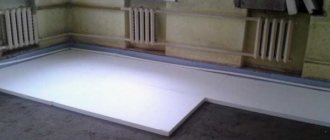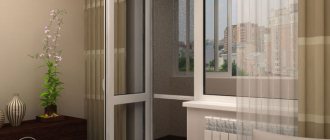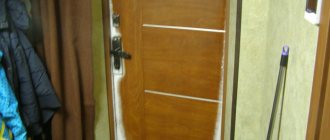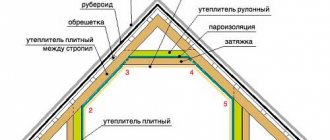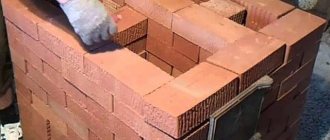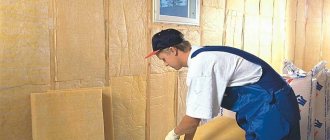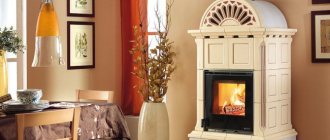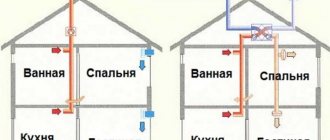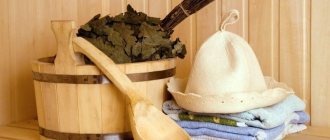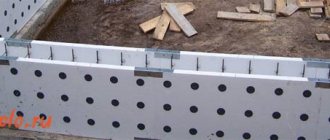In order for the temperature in the bathhouse to be maintained for as long as possible, and the costs of maintaining it to be as low as possible, bathhouses need external insulation. In addition to solving this problem, external insulation also protects the building from direct contact with cold air and precipitation, which extends the life of the building.
The order and sequence of work on external insulation depends on the type of material used for construction. For bathhouses made of logs - rounded or simply sanded - this usually involves careful sealing of all cracks and cracks: wood of sufficient thickness holds heat well on its own. Sometimes the steam room and washing room are insulated from the inside.
If timber is used during construction, it most likely needs to be insulated, but how depends on its thickness and region (you need to know how severe the winters are). It is imperative to insulate baths built from bricks and building blocks - they have high thermal conductivity and to ensure the required temperature conditions, the wall thickness must be at least 80 cm, which is very unprofitable from an economic point of view. That’s why such baths are always insulated.
How to insulate a log sauna from the outside
Almost all insulation of a log bath comes down to carefully sealing the cracks. Even during construction, a special jute insulation was laid between the crowns, but over time the wood dries out, cracks, and new cracks form, which need to be caulked regularly.
Insulation of a log bath
After erecting the frame and caulking the cracks, the building must remain under the roof for at least six months. It is advisable not to use the bathhouse during this time. The log house will shrink, the wood will dry out, and new cracks and gaps will appear. These are the ones that need to be caulked. For this purpose, a special insulation based on jute and flax is used. Jute itself conducts heat poorly and does not burn, but its disadvantage is low elasticity (it tears easily). To solve this problem, flax fibers are added to the insulation for log houses. Thin strips of material are driven into the cracks using a hammer and a special metal caulking blade. This must be done carefully to prevent distortion of the structure.
There is also a special sealant for sealing cracks in wooden buildings. It’s easier to work with: a special syringe fills all available voids.
Insulating a log bath using sealant
A log house shrinks within two years. At this time, it is not recommended to cover it with finishing materials. This way you will have access to newly appearing cracks that need to be periodically sealed from the inside and outside. To protect the insulation from the effects of precipitation, the outside of the building can be covered with film, securing it with strips.
Two years after construction, you can begin finishing. For many this will sound ridiculous, but structures made of logs can be sheathed with a block house, clapboard, imitation timber, or dies. To begin with, a sheathing is mounted on the wall (if it is made of wood, it must be treated with antibacterial impregnations and increases resistance to fire), which is checked for verticality and horizontality using a building level.
Lathing for insulation and finishing
Finishing material is attached to the sheathing, which is then coated with varnish or other protective compounds. If you choose metal guides, they are mounted on special hangers.
Insulation on the outside of a log bath is almost never used, and the inside is only sometimes additionally insulated in the steam room and washing room. If you decide to play it safe and insulate the building, if the insulation is afraid of moisture, a vapor or water barrier is laid on top of it. It is secured using strips, onto which the trim is subsequently attached.
Modes of using a bathhouse and the need for external insulation
If the owner expects occasional use of the object for its intended purpose (no more than once a week), he expects the steam room to completely cool down between sessions. That is, internal insulation is arranged based on rapid heating with a rise in temperature from the street temperature to 60 ° C - 90 ° C. In this case, installing thermal insulation on the street side does not make sense: in winter, this measure will not save the building from freezing for 3-4 days. The cooling of the room will slow down, but in the end, almost as much energy will need to be spent on each heating as in the absence of external insulation.
Insulation of bath walls from inside and outside
When using a steam room every 2 - 3 days, the question is “how to cover the outside of the bathhouse?” is no longer idle for materials with high heat capacity (brick, concrete). Daily use (for example, for commercial purposes) makes it advisable to cover the bathhouse with insulating materials on both sides, regardless of the type of load-bearing walls.
Another option for using a bathhouse that justifies double-sided insulation, regardless of the heat capacity and vapor permeability of the rough walls, is to conduct several paired sessions within one day. At the same time, the bathing day itself may not be repeated often.
Insulation of a bathhouse made of timber from the outside
The insulation of a bathhouse made of timber from the outside is absolutely no different from the insulation of a bathhouse made of logs. The building must also stand, cracks also appear in it, which are sealed in the same way.
Insulation of a bathhouse made of timber
The need for external insulation depends on the thickness of the timber. If its thickness is insufficient for your climate zone, insulation will need to be done according to the following scheme:
- lathing made of timber or metal guides (be sure to align them in both horizontal and vertical planes);
- heat insulator (thickness depends on the climate zone, wall thickness, and type of thermal insulation);
- moisture and wind protection;
- counter lathing (not necessary, but there should be a gap between the protective film and finishing materials);
- Decoration Materials.
Insulation of a bathhouse from the outside The
outside of a bathhouse is usually sheathed from timber: clapboard of any type, edged board, siding, metal profile, block house, etc. After completion of the work, the wooden finish is coated with varnishes for exterior use, sometimes pre-treated with coloring pigments, but many modern compositions also have a tinting effect, which, of course, is convenient.
If siding is used as a finishing material, then the presence of a ventilation gap between the insulation and the finishing is mandatory. In this case, it is advisable to use special guides as lathing, which can be purchased in the same place where siding is purchased. The guides are mounted on special hangers.
Metal siding guides are mounted on special hangers
How to properly insulate a roof?
Scheme of a properly insulated roof structure
The question of whether it is necessary to insulate the roof of a bathhouse or not can only arise from an inexperienced owner. Experts know that high-quality insulation of this area will reduce heat loss by as much as 30%. Work is carried out along the perimeter of floors and slopes in the following order:
- At the first stage, the object is waterproofed - if this requirement was ignored during the construction of the building, a moisture-proof and vapor-proof membrane will still have to be laid over the rafters. True, now, for this it will be necessary to dismantle part of the roofing material.
- Next, all roof elements are treated with an antiseptic - if such a procedure has not been carried out previously.
- After preliminary preparation, the insulation itself is installed directly - slabs or rolls of balsat fiber have proven themselves exclusively on the positive side.
- The final stage involves internal covering of the laid material - even an ordinary vapor barrier film that is attached to the rafters will do; ideally, the structure is sheathed with clapboard.
Next to the roof, you can think about how to insulate a bathhouse made of timber from the outside.
Insulation of a brick bathhouse from the outside
It is imperative to insulate a brick bathhouse from the outside - this material has high thermal conductivity, so without external insulation it will be extremely difficult to warm the room to the required conditions. The sequence of insulation is the same: frame, insulation, moisture and wind insulation, ventilation gap, sheathing.
Insulation scheme for a brick bath
For external insulation, it is usually recommended to use mineral wool. According to recent studies, they are not suitable for internal insulation of a bathhouse - they emit formaldehyde, but for external insulation they are one of the best options. You can also insulate a brick bathhouse from the outside with polystyrene foam boards, polystyrene foam (it is cheaper, but polystyrene is more durable), foam glass (its disadvantage is its high price). To ensure high-quality work, it is recommended to lay two layers intercut (offset by half the length) to reduce heat loss by overlapping the seams. But this method takes more time, and it takes twice as much materials for insulation. Therefore, most often, insulation is done in one layer, tightly laying one mat to another, and the joints are taped with reinforced tape.
Fabric reinforced PVC tape
To cover the outside of a brick bathhouse, you can use wooden finishing materials or siding. There is another option for exterior finishing: you can decorate the outside of the bathhouse with plaster. This is possible if polystyrene boards, foam glass or foam plastic were used as insulation. Then a reinforcing mesh is placed on top of this material, a primer is applied, and then the walls are plastered.
Scheme of insulation of a brick bath and finishing with plaster
You can insulate a brick bathhouse using the type of ventilated facade. In this case, special L-shaped brackets are attached to the wall (the installation step is 1 cm less than the width of the insulation), between which mats or insulation boards are tightly installed.
Insulation scheme for a brick bathhouse based on the principle of a ventilated facade
For reliability, they can be reinforced with special dowels, but this is not necessary - the material itself must hold quite firmly (that’s why they make the fastening step of the guides 1 cm less than the width of the insulation - it is held in place by elastic force). The joints of the slabs are glued with reinforced tape, or treated with special glue, a waterproofing film is laid on top, and secured with strips. Now guides are installed on the brackets, which support the insulation and at the same time serve as the basis for installing the exterior trim. Using this scheme, you can also insulate baths made of foam blocks, cinder blocks or aerated concrete.
Is it necessary to insulate the foundation of a bathhouse from the outside?
To make sure of the importance of external foundation insulation, it is worth considering 5 reasons:
- On a cold foundation in winter, a temperature difference forms in a heated bathhouse. The resulting condensation destroys the concrete base.
- The problem with condensation occurs even in summer. An uninsulated foundation is heated by the sun from the outside, but the cold and moisture of the earth is drawn from the inside. The temperature difference is similar.
- A foundation that is not insulated from the outside cools the steam room faster. The bathhouse has to be heated more often.
- On the outside, thermal insulation in winter softens the impact of heaving soil on the foundation.
- A thick layer of thermal insulation on the outside protects the foundation from destruction and accidental mechanical influences.
The listed 5 reasons convince us that insulating the foundation of a bathhouse from the outside is necessary. It can be carried out simultaneously with thermal insulation from the inside. It is impossible to do only internal insulation of the base of the bathhouse. Due to temperature changes, concrete will begin to collapse on the street side.
How to insulate the foundation of a bathhouse from the outside with your own hands
There are different ways to insulate the base from the outside. They all depend on the type of soil where the bathhouse is built, as well as on the design of the foundation itself.
The strip foundation is dug around the outside with a trench 50 cm wide. The depth is maintained at least 80 cm. A 20 cm layer of sand is poured into the trench. The concrete strip is cleaned of dirt and treated with hot bitumen. After the waterproofing has hardened, the base is covered with polystyrene foam or polystyrene foam. Plates 15 cm thick are glued with foam and additionally secured with dowels and umbrellas. When using expanded polystyrene, the gap between the trench wall and the insulation is filled with sand. The foam is covered with a brick wall. From above, the entire pie around the base is filled with a concrete blind area at an angle of 15 degrees.
A monolithic foundation is usually laid under a bathhouse in a swampy area. The base is insulated during the construction stage. Expanded polystyrene is embedded between the layers of concrete screed. On the walls outside the foundation of the bathhouse, insulation with your own hands occurs according to the principle of a strip base.
The columnar foundation creates a gap between the soil and the lower crown of the bathhouse. To insulate it, it needs to be bricked. First, a trench is dug along the perimeter of the bathhouse. The parameters are the same as for insulating a concrete strip. The bottom of the trench is covered with a 25 cm layer of sand and filled with water. When the pillow is compacted, they begin to lay out the wall. Concrete can be poured up to the ground level, and rows of bricks can be laid above. A gap is left between the last row and the crown of the bath and filled with polyurethane foam. The built base is insulated from the outside using the strip foundation method.
Finishing the outside of a bathhouse made of blocks
Any of the insulation schemes described above can be applied to block baths. In addition, there is another option: to cover such a bathhouse with decorative bricks, but this option of finishing and insulation is possible if the temperature in the bathhouse is maintained above zero at all times.
Exterior decoration of the bathhouse with decorative bricks
If you decide to line a bathhouse made of blocks with bricks, you can lay out the second wall not closely, but retreating 5-10 centimeters. In this case, the thermal insulation characteristics of the building will be much improved. The gap can be left empty, or it can be filled with thermal insulation material: expanded clay, sawdust that has undergone special treatment, etc.
Insulation scheme for aerated concrete baths
To prevent moisture from accumulating in the space between the walls, small ventilation gaps are left in the outer wall, and to securely fix the finishing wall, small pieces of fastening reinforcement are driven into the load-bearing wall.
Recently, finishing material such as a block house, which emits a log wall, has become increasingly popular. Block houses are made from different materials: PVC (vinyl), metal or wood. A bathhouse made of blocks, lined with a block house, looks as if it is made of wood.
Block bathhouse covered with a block house
Material selection
The insulation must meet certain criteria:
- can withstand elevated temperatures well;
- have low hygroscopicity (tendency to absorb moisture);
- do not deform: do not fall off or roll;
- not be prone to rotting and do not attract rodents;
- be environmentally friendly.
To insulate a timber bath from the outside, materials such as:
- Natural: felt, fluff, cotton wool. They are used primarily for log structures. The material covers the space between the logs.
- Backfills: these are small granules that come in different sizes and densities. They are made using foaming technology or other ways. Such products can be applied in different ways, in particular by spraying with water.
- Blocks: compact and fairly light foam boards, for example, foam glass.
- Rolls, a little
conclusions
A log bathhouse, built in Russian traditions, as a rule, does not require additional insulation of the walls either outside or inside.
When choosing external insulation for a brick or block bathhouse, the choice is very wide. Without harming your health, you can use mineral wool made using phenol-formaldehyde resins, which is not recommended for insulating the inside of a bathhouse. Styrofoam and polystyrene foam are also suitable.
If you have the financial means, the bathhouse can be covered with a metal block house, which will serve for many years.
What materials are suitable for insulating a bath?
- In order to retain heat in a heated bathhouse for a long time, it is necessary to insulate the walls of the bathhouse on both sides. Insulation materials for internal thermal insulation must be environmentally friendly and meet sanitary standards.
- Insulation based on mineral wool has a low thermal conductivity. It is highly hygroscopic and therefore requires reliable waterproofing. Its use is undesirable for interior decoration. When exposed to high temperatures, mineral wool releases harmful substances. When using mineral wool indoors, waterproofing is necessary not only to protect the material from moisture, but also as a barrier against harmful fumes entering the room.
- Polystyrene also releases harmful substances when heated. For this reason, it is not used for internal thermal insulation of baths.
- Finnish sauna insulation SPU Sauna-Satu has high thermal insulation ability. Produced in slabs measuring 600x1200 mm. Thickness 30 mm. The material does not support combustion. Does not absorb moisture. Due to the fact that the material does not produce harmful fumes when heated, SPU Sauna-Satu insulation is recommended for indoor use. In particular, for finishing steam rooms and saunas. Installation is carried out directly on the wall without lathing.
- Insulating the walls of a bathhouse from the outside has the goal of protecting the building structure from atmospheric influences - cold air and precipitation. The insulation method is chosen depending on the building materials from which the bathhouse is built. Almost any type of insulation is suitable for external insulation.
- To insulate the walls of a frame bath, you should choose a material with low weight so as not to create excessive load on the walls.
- Foiled thermal insulation Penotherm NPP LF is produced especially for finishing the steam room. This insulation is made of NPP foamed polypropylene, laminated on one side with aluminum foil. Combines the qualities of heat and waterproofing. The material is resistant to high temperatures. Has a thickness from 3 to 10 mm.
- To insulate brick walls, which has high thermal conductivity, you will need material 8-100 mm thick. For wooden baths, insulation with a thickness of 3 to 5 mm is suitable.
- Special materials are used for vapor and waterproofing. The GEXA company produces Izospan films and membranes. Proper waterproofing helps preserve the properties of the insulation and prevents the formation of condensation.
Insulation of a steam room in a wooden bath
Just as in most cases a wooden bathhouse does not need any insulation other than sealing the cracks, its steam room is able to perform its functions without additional effort. Unless the owner sets the task of making a sauna out of a bathhouse, which differ in temperature and air humidity. But even in this case, it is enough to simply lay a layer of foil or foil-coated kraft paper without installing any insulation.
The foil is placed behind the lining, but never end-to-end, but with a ventilation gap so that the lining can dry out. There should also be an air gap between the foil and the timber wall. If you are making a “thermos” from a steam room, you should not use coniferous wood in the lining, so as not to get burns from the resin.
Let's put it this way : insulating a steam room in a wooden bathhouse, if we don't talk about using foil, is a very strange event.
Do you need foil in the steam room?
The debate about foil will never end; it has many supporters and opponents. But, as a fact, a steam room with foil becomes hotter, and the steam in it becomes harsher . Therefore, it is a matter of the owner's taste. On the other hand, mistakes during its installation can be costly; if the wood gets wet, mushrooms and rot will develop. As experts say: try steaming without foil, you will always have time to put it on.
Find out more about the use of foil and foil insulation in baths.
Insulation of wooden baths
Problem areas in a wooden structure are always the same. The problem can be solved either the way it has been done for centuries, or with the help of modern technologies. Below is a list of problems and ways to solve them.
Inter-crown insulation and sealing of cracks
Over time, wooden buildings inevitably shrink, which causes gaps to appear between the crowns. Those, in turn, open the way for drafts, so the first stage of the fight is to seal them.
The initial stage of interventional insulation occurs during construction . Timber (including profiled) and round timber are laid with tow tape or jute. Subsequently, this will be internal interventional insulation.
In addition to the internal, there is also an external one, which has to be periodically updated.
The resulting cracks can be filled with tow, jute, natural moss, or you can use modern materials, but only those designed for wood. IMPORTANT ! Plumbing sealants, putty and polyurethane foam are not suitable for sealing cracks in a bathhouse made of logs or timber.
They are inelastic, designed for a constant gap size (and in wood it changes), they have poor adhesion to wood, insufficient heat resistance, harmful emissions and other disadvantages. Over time, they crumble out of the cracks. The cracks on the outside of the beams or logs are sealed with wood sealants in such a way that the sealants will dry from 2 to 5 weeks, and the walls must be protected from the sun and rain during this time.
Insulation of window and door openings
Windows in bathhouses are usually made low so that the heat accumulated under the ceiling does not escape . All openings - both window and door - must be carefully sealed with tow or foam. For ordinary windows, the junction of glass and frames is insulated with putty, but it is even better to install special double-glazed windows for baths - made of wood.
High thresholds and low doors
Bathhouse builders have long developed design features that help retain heat.
And even in our time there is a reason to take advantage of their findings. However, there are several doors in the bathhouse; should they all be low and the thresholds high? The principle on which this works is that warm air is light and accumulates at the top, so the higher the doorway, the more heat will escape when the door opens. A high threshold prevents drafts from moving across the floor and also effectively saves heat.
But today this rule is more often followed for only one room in the bathhouse - the steam room (about insulation for the steam room here). The calculation is simple: you need a pair from the ceiling 60-80 cm down, at this level you can already make a door lintel. Or you can use another rule: from the floor to the ceiling the door is 160 cm in height. From this height you still need to subtract 20 cm per threshold.
By the way, a high threshold is a guarantee that you won’t hit your head, because a person automatically ducks when he steps over it. And if you make the doorway wider, it will become comfortable even at this height.
IMPORTANT ! The door to the steam room should open outward, not inward. You never know, maybe you'll have to knock it out from the inside.
It is better to make the door to the washing room narrow, about 60 centimeters, so that less moisture leaves the room. Another thing: due to the swelling of the wood, the gap between the door and the frame is increased to 5 mm, so that the swollen door can still close. This does not apply to glass and plastic doors.
The entrance door to the bathhouse can also be ordinary in size, but in terms of material it is better to be metal with wooden lining, so as not to accidentally freeze to the metal in the cold. But the wooden one usually swells and leads .
Bath insulation process
When building a sauna from timber, insulation is necessary if you plan to steam in the winter or the heat emanating from the stove is not enough to heat the steam room to the required temperature. To understand how to insulate a wooden bathhouse, you should study a large number of materials on this topic. This will help to avoid a large number of errors and problems that may arise directly at the stage of installation of thermal insulation materials, which may increase the work time.
The bath is insulated from the inside, outside and inside the wall. In-wall thermal insulation is installed as the walls are being built. A layer of mineral wool or other heat-insulating materials is laid between the inner and outer walls. The bulk of the work on internal insulation is carried out before finishing the interior. The exception to the rule is the floor and attic floors.
Bathroom floor insulation
Before you start insulating the attic floor, you should take care of the vapor barrier. To provide vapor barrier, glass hydroisol, roofing felt or polyethylene are used. The next layer is expanded clay, slag or fiberboard. The main requirements that should be presented to the insulation are: fire resistance, the quality of the thermal insulation layer should be equal to the same value as 25 centimeters of mineral wool. A screed of sand and cement, at least 3 centimeters thick, is laid on top of the heat-insulating layer, on top of which walking boards are laid.
Insulating the steam room of a log bath begins with insulating the walls from the inside. It is recommended to install heat and vapor barrier under materials such as gypsum fiber, plasterboard, magnesite. Undoubtedly, this will reduce the usable area of the room, but the amount of heat retained will significantly increase.
Insulation of the steam room of a bath
Insulation of a wooden bathhouse from the outside begins with insulation of its facade, at the stage of wall construction. To do this, inter-crown insulation is laid between the logs of the log house, which can be either ordinary tow or more modern insulation made from jute and flax. The thickness of the inter-crown for baths made of brace should not be less than 0.5-1 centimeters, and from a log house – 1.5 centimeters.
The optimal time to insulate the facade is mid-summer. During this period there are no sharp, abrupt fluctuations in temperature and humidity. Before you begin work on insulating the facade, it should be treated with agents that protect against rotting processes and prevent fire. If necessary, the inter-crown cracks are caulked. The façade is insulated with mineral wool, polyurethane foam, and polystyrene foam. Each layer of insulation must be secured with anchors, ensuring that the joint below the previous row overlaps the top one, resembling brickwork.
Bathhouse in the process of insulation
To prevent the formation of condensation during changes in temperature and air humidity, vents are provided under the sheathing and in the thickness of the foundation - special ventilation holes through which water vapor is discharged along with ventilation air flows.
To choose the right insulation, you should enlist the help of professionals and learn as much as possible on your own. Before you start insulating a wooden bath, you should plan everything carefully.
Having learned how to insulate a timber bathhouse as a whole, you should dwell in more detail on the most important part. Thermal insulation of the steam room is of greatest importance, because it is important to quickly create and constantly maintain high temperatures (from 60 to 130 degrees Celsius)
In a Russian bath, the optimal temperature is considered to be 60-90 degrees Celsius, since heat is achieved through high humidity, while a Finnish sauna requires higher temperatures, up to 130 degrees Celsius, due to dry air.
The importance of reducing heat loss is that a certain amount of fuel is needed to create the required temperature, and the more heat is lost, the more expensive it will be to light the bathhouse. In addition to this drawback, there is another, more global
Due to high heat losses and the use of large amounts of fuel, the service life of a bathhouse or sauna is significantly reduced, which entails additional costs for repairs and the purchase of fuel.
Ultimately, in some cases, heat loss can exceed heat output, and then the room will not warm up at all. In order to avoid home problems, you should arrange high-quality thermal insulation, which will retain all the healing properties of a real bathhouse, and will also warm up quickly and for a long time, giving warmth to its visitors.
: 2 289


